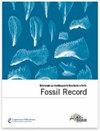下载PDF
{"title":"A juvenile Early Carboniferous (Viséan) coelacanth from Rösenbeck (Rhenish Mountains, Germany) with derived postcranial characters","authors":"Florian Witzmann, Markus Dorka, Dieter Korn","doi":"10.1002/mmng.201000004","DOIUrl":null,"url":null,"abstract":"<p>A small coelacanth specimen of Viséan age from a newly described locality near Rösenbeck at the northern margin of the Rhenish Mountains (North Rhine-Westphalia, Germany) is described. The head and pectoral girdle are not preserved, however, the specimen can be distinguished from all other known Carboniferous coelacanths by derived characters of the articulated postcranial skeleton. Derived characters include: (1) The slender first and second dorsal fins that carry only seven to eight and six fin rays, respectively. (2) Both the pelvic and anal fin have a broad base and are unusually weakly lobed. (3) The fin rays of the second dorsal fin are much more robust than those of the first dorsal fin. (4) The second dorsal and anal fins are longer than the first dorsal and pelvic fins. The Rösenbeck coelacanth is interpreted as a juvenile specimen, since the basal plates that support the fins are not ossified. (© 2010 WILEY-VCH Verlag GmbH & Co. KGaA, Weinheim)</p>","PeriodicalId":55147,"journal":{"name":"Fossil Record","volume":"13 2","pages":"309-316"},"PeriodicalIF":2.1000,"publicationDate":"2010-08-05","publicationTypes":"Journal Article","fieldsOfStudy":null,"isOpenAccess":false,"openAccessPdf":"https://sci-hub-pdf.com/10.1002/mmng.201000004","citationCount":"6","resultStr":null,"platform":"Semanticscholar","paperid":null,"PeriodicalName":"Fossil Record","FirstCategoryId":"89","ListUrlMain":"https://onlinelibrary.wiley.com/doi/10.1002/mmng.201000004","RegionNum":4,"RegionCategory":"地球科学","ArticlePicture":[],"TitleCN":null,"AbstractTextCN":null,"PMCID":null,"EPubDate":"","PubModel":"","JCR":"Q3","JCRName":"Earth and Planetary Sciences","Score":null,"Total":0}
引用次数: 6
引用
批量引用
Abstract
A small coelacanth specimen of Viséan age from a newly described locality near Rösenbeck at the northern margin of the Rhenish Mountains (North Rhine-Westphalia, Germany) is described. The head and pectoral girdle are not preserved, however, the specimen can be distinguished from all other known Carboniferous coelacanths by derived characters of the articulated postcranial skeleton. Derived characters include: (1) The slender first and second dorsal fins that carry only seven to eight and six fin rays, respectively. (2) Both the pelvic and anal fin have a broad base and are unusually weakly lobed. (3) The fin rays of the second dorsal fin are much more robust than those of the first dorsal fin. (4) The second dorsal and anal fins are longer than the first dorsal and pelvic fins. The Rösenbeck coelacanth is interpreted as a juvenile specimen, since the basal plates that support the fins are not ossified. (© 2010 WILEY-VCH Verlag GmbH & Co. KGaA, Weinheim)
一条产自Rösenbeck(德国莱茵山脉)的早石炭世幼鱼腔棘鱼,具有派生的颅后特征
描述了来自莱茵山脉(德国北莱茵-威斯特伐利亚州)北部边缘Rösenbeck附近新描述的一个小腔棘鱼标本。头部和胸带没有保存下来,然而,该标本可以从所有其他已知的石炭纪腔棘鱼的关节后颅骨衍生特征区分开来。衍生的特征包括:(1)细长的第一和第二背鳍,分别只有7到8条鳍和6条鳍。(2)盆鳍和肛鳍都有一个宽的基部,并且异常弱裂。(3)第二背鳍的鳍线比第一背鳍的鳍线要粗壮得多。(4)第二背鳍和肛鳍比第一背鳍和腹鳍要长。Rösenbeck腔棘鱼被解释为幼年标本,因为支撑鳍的基板还没有骨化。(©2010 WILEY-VCH Verlag GmbH &KGaA公司,Weinheim)
本文章由计算机程序翻译,如有差异,请以英文原文为准。

 求助内容:
求助内容: 应助结果提醒方式:
应助结果提醒方式:


